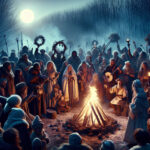Neo-paganism is a diverse spiritual and religious movement that has been growing in popularity in recent years. It is an umbrella term used to describe a broad range of spiritual and religious practices, beliefs, and traditions that are inspired by ancient paganism, polytheism, and animism. This article will explore the history and core beliefs of neo-paganism and discuss its current popularity and its future potential.
Neo-Paganism is a modern religious movement that seeks to revive ancient religions and spiritual beliefs. It is a broad term that encompasses many different traditions, and can include Wicca, Witchcraft, Druidry, Shamanism, Heathenry, and many others. Neo-Paganism is a growing spiritual movement, but there is still much confusion and misunderstanding about it.
What is Neo-Paganism?
Neo-Paganism is a modern religious movement that seeks to revive ancient religions and spiritual beliefs. It is a broad term that encompasses many different traditions, from Wicca, Witchcraft, Druidry, Shamanism, Heathenry, and many others. The common thread between these traditions is a celebration of nature and the divine feminine, a focus on personal growth and transformation, and an emphasis on connection to the land and the cycles of nature.
Neo-Pagans often honor a variety of deities and spirits, and many traditions include rituals and ceremonies to honor these divine beings. Neo-Paganism is an earth-based, nature-centered spirituality that celebrates the cycles of the seasons and the rhythms of the natural world.
The Origins of Neo-Paganism
Neo-Paganism has its roots in the ancient pagan religions of Europe, such as Druidry, Wicca, and Witchcraft. These ancient religions were largely suppressed during the Christianization of Europe, and the practices and beliefs of these traditions were largely lost.
In the mid-twentieth century, a resurgence of interest in these ancient religions began to emerge. Scholars such as Margaret Murray, Robert Graves, and Gerald Gardner began to research and revive these ancient traditions. Many of the traditions that are now part of Neo-Paganism began as a result of this work.
Neo-Pagan Beliefs and Practices
Neo-Paganism is a modern religious movement, but it is also an umbrella term for a variety of different spiritual traditions. As such, there is no single set of beliefs or practices that can be said to define Neo-Paganism.
Many Neo-Pagans believe in the existence of the divine, or the sacred, in some form. Some traditions focus on the worship of a single deity, while others may honor a variety of deities, spirits, and ancestors.
Neo-Pagans may also believe in the power of magic and the potential of the human spirit to manifest change in the world. Rituals and ceremonies are an important part of many Neo-Pagan traditions, and may include meditation, drumming, chanting, and the casting of spells.
Neo-Paganism and Nature
Neo-Paganism is often described as an “earth-based” or “nature-centered” religion, and many Neo-Pagans believe in the importance of living in harmony with the environment. Nature is seen as sacred, and many Neo-Pagans strive to be mindful of their impact on the natural world.
Neo-Pagans also celebrate the cycles of the seasons, and many traditions have rituals and festivals that honor the changing of the seasons. These rituals may include honoring the solstices and equinoxes, or celebrating the full moons.
Neo-Paganism and Community
Neo-Paganism is often practiced in small groups or communities, which are referred to as covens, groves, or circles. These communities provide a supportive environment for individuals to explore and practice their spirituality. Many of these groups also host workshops, classes, and rituals for those interested in learning more about Neo-Paganism.
Neo-Paganism is a growing movement, and there are many online resources available for those interested in learning more. There are also local groups and organizations in many parts of the world, which can provide an excellent opportunity for those interested in connecting with other Neo-Pagans in their area.
Conclusion
Neo-Paganism is a modern religious movement that seeks to revive ancient religions and spiritual beliefs. It is a broad term that encompasses many different traditions, from Wicca, Witchcraft, Druidry, Shamanism, Heathenry, and many others. Neo-Pagans often honor a variety of deities and spirits, and celebrate the cycles of the seasons. Neo-Paganism is an earth-based, nature-centered spirituality that emphasizes living in harmony with nature and connecting with the divine.
Neo-Paganism is a modern religious movement that has its roots in ancient pagan religions. It is a spiritual practice that emphasizes nature, respect for the environment, and a connection to the divine. Neo-Paganism draws on a wide range of spiritual sources, including traditional folk religions, Wicca, and New Age spirituality. Neo-Pagans strive to create a sense of community and connection to the Earth and its inhabitants. They also seek to promote personal growth and transformation through rituals, meditation, and other spiritual practices. Neo-Paganism is an ever-evolving religious movement that encourages individuals to explore their own spiritual paths and find their own unique connection to the divine. Neo-Paganism is a spiritual practice that encourages individuals to explore their own spiritual paths and to find their own unique connection to the divine.





